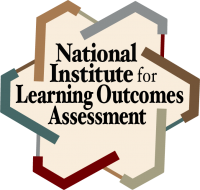Description
The Associate level portfolio presentation is designed to measure applied learning and is organized around three educated citizen outcomes: reflective individual, effective communicator, and change agent. The Bachelor’s level capstone presentation is also designed to examine students’ development as educated citizens. Aggregate data from these assignments is used to measure overall student progression regarding Educated Citizen outcomes and to make adjustments at course and curricular levels.
Background and Context
NMC developed the Educated Citizen Core Curriculum for all degree-seeking students in 2006. Upon adoption, this new core curriculum was integrated with the campus wide portfolio program which had been in place since 1998. The portfolio is organized around the three Educated Citizen outcomes (reflective individual, effective communicator, change agent); throughout their time at NMC, students compile artifacts related to the three goals and write critical reflections to connect the experiences to learning. Students at both the associate and bachelor’s degree level complete final capstone presentations in which they examine their development as educated citizens. Aggregate student data from these assignments is used to measure overall student progression regarding Educated Citizen outcomes and to make adjustments at course and curricular levels.
Both assignments are developed in capstone courses. Associate degree students take a required zero-credit course, COM 290: Portfolio Synthesis. Bachelor’s degree students take a required 3-credit political science course, SSC 465: Capstone: The Educated Citizen.
Reflections
Students are enrolled in COM290 during the final semester of their associate degree program. Students are grouped by their programs to give the 15-minute portfolio presentation. A panel of three faculty and staff grade the presentations; they must receive a passing grade to graduate.
Students are enrolled in SSC 465 during the final semester of their senior year. While they are made aware of the presentation throughout their program of study, the assignment details are shared explicitly during the first SSC 465 class. Since the presentation begins with a social analysis of a public problem, in SSC 465 students complete a multi-step public problem analysis project in an effort to prepare them for the presentation. Students also complete three senior-level portfolio reflections in which they analyze their learning in the Educated Citizen goals of Reflective Individual, Effective Communicator and Change Agent. The integrative focus of the assignment is strongly reinforced in class lectures which emphasize the importance of transference of skills and knowledge to address community as well as personal and professional problems. A panel of three faculty and staff grade the presentations. The capstone presentation comprises about 20% to 25% of the student’s course grade.
The Associate level portfolio presentation is designed to measure associate level Applied Learning outcomes. Specifically, the following outcome is measured:
- Describes in writing a case in which knowledge and skills acquired in academic settings are applied to a challenge in a non-academic setting; evaluates the learning gained; and analyzes a significant concept or method related to the course of study in light of learning from outside the classroom.
The Bachelor’s level capstone presentation is designed to measure Bachelor’s level Applied Learning and Civic Learning outcomes. Specifically, the following outcomes are measured:
- Presents a discrete project, paper, exhibit or performance, or other appropriate demonstration that links knowledge and/or skills acquired in work, community and/or research activities with knowledge acquired in one or more disciplines; explains in writing or another medium how those elements were combined in the product to shape its intended meaning or finding; and employs appropriate citations to demonstrate the relationship of the product to literature in its field.
- Formulates a question on a topic that addresses more than one academic discipline or practical setting, locates appropriate evidence that addresses the question, evaluates the evidence in relation to the problem’s contexts, and articulates conclusions that follow logically from such analysis.
- Explains diverse positions, including those of different cultural, economic and geographic interests, on a contested issue, and evaluates the issue in light of both those interests and evidence drawn from journalism and scholarship.
- Develops and justifies a position on a public issue and relates the position taken to alternative views within the community/policy environment.
Please select an option
The assignment library and the assignments within are licensed under a Creative Commons Attribution 4.0 International License. By clicking “Ok” you agree to cite each assignment (including modifications), with the provided citation on the assignments downloaded from this site.
OK

